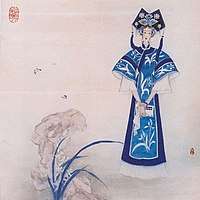Consort Donggo
Empress Xiaoxian (1639 – 23 September 1660), of the Manchu Plain White Banner Donggo clan, was a consort of the Shunzhi Emperor. She was one year his junior.
| Empress Xiaoxian | |||||
|---|---|---|---|---|---|
 | |||||
| Born | 1639 (崇德四年) | ||||
| Died | 23 September 1660 (aged 20–21) (順治十七年 八月 十九日) Chengqian Palace, Forbidden City | ||||
| Burial | Xiao Mausoleum, Eastern Qing tombs | ||||
| Spouse | |||||
| Issue | Fourth son | ||||
| |||||
| House | Donggo (董鄂; by birth) Aisin Gioro (by marriage) | ||||
| Consort Donggo | |||||||
|---|---|---|---|---|---|---|---|
| Traditional Chinese | 孝獻皇后 | ||||||
| Simplified Chinese | 孝献皇后 | ||||||
| |||||||
Life
Family background
Empress Xiaoxian's personal name was not recorded in history. Her ancestral home was in Liaoning.
- Father: Eshuo (鄂碩/鄂硕; d. 1657), served as a first rank military official (內大臣)
- Paternal grandfather: Xihan (席漢/席汉)
- One younger brother
Shunzhi era
In the summer of 1656, Lady Donggo entered the Forbidden City and was deeply loved and favoured by the Shunzhi Emperor. On 12 October 1656, she was granted the title "Consort Xian". On 19 January 1657, she was elevated to "Imperial Noble Consort".[1] The Shunzhi Emperor held a grand ceremony for the promotion of Lady Donggo and proclaimed an amnesty.[1]
On 12 November 1657, Lady Donggo gave birth to the emperor's fourth son. The premature death of their son on 25 February 1658 had a great impact on Lady Donggo and the Shunzhi Emperor. Lady Donggo fell ill and died on 23 September 1660. The Shunzhi Emperor was so overwhelmed with grief that he stopped attending daily court meetings for five days to mourn Lady Donggo. It was also said that the Shunzhi Emperor was so depressed that he wanted to commit suicide, and his subjects had to watch over him every day for fear of his safety.[2] Two days after her death, Lady Donggo was posthumously granted the title of Empress, an uncommon gesture.[3] She was interred in the Xiao Mausoleum of the Eastern Qing tombs.
Titles
- During the reign of Hong Taiji (r. 1626–1643):
- Lady Donggo (from 1639)
- During the reign of the Shunzhi Emperor (r. 1643–1661):
Issue
- As Imperial Noble Consort:
- The Shunzhi Emperor's fourth son (12 November 1657 – 25 February 1658)
In fiction and popular culture
- Portrayed by Ko Miusze in The Duke of Mount Deer (1984)
- Portrayed by Ng Ning in The Rise and Fall of Qing Dynasty (1987)
- Portrayed by Bo Hong in Kangxi Dynasty (2001)
- Portrayed by Shu Chang in Xiaozhuang Mishi (2003)
- Portrayed by Océane Zhu in The Life and Times of a Sentinel (2011)
- Portrayed by Zhang Xueying in In Love with Power (2012).
See also
- Ranks of imperial consorts in China#Qing
- Royal and noble ranks of the Qing dynasty
Notes
- Draft History of Qing, ch. 5 ("Basic Annals 5" [本紀]), p. 147. The date is indicated as the jimao 己卯 day of the 12th month of the 13th year of Shunzhi.
- Li Lanqin 李兰琴, Tang Ruowang zhuan 汤若望传 [Biography of Tang Ruowang (Adam Schall)], Dongfang chubanshe 东方出版社, 1995.
- Draft History of Qing, ch. 5 ("Basic Annals 5" [本紀]), p. 160; date indicated as SZ17.8.甲辰 (21st day of that month).
- 順治十三年 八月 二十五日
- 順治十三年 十二月 六日
- 順治十七年 八月 二十一日
References
| Chinese royalty | ||
|---|---|---|
| Preceded by Empress Xiaokangzhang |
Empress of China Posthumous |
Succeeded by Empress Xiaochengren |